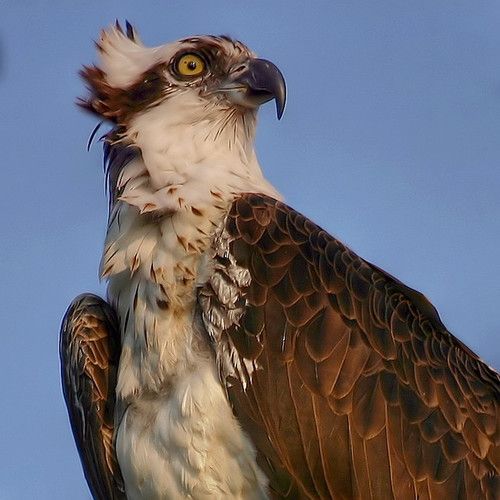The Osprey

The Osprey or more specifically the western osprey (Pandion haliaetus) — also called sea hawk, river hawk, and fish hawk — is a diurnal, fish-eating bird of prey with a cosmopolitan range. It is a large raptor, reaching more than 60 cm (24 in) in length and 180 cm (71 in) across the wings. It is brown on the upperparts and predominantly greyish on the head and underparts.
The osprey tolerates a wide variety of habitats, nesting in any location near a body of water providing an adequate food supply. It is found on all continents except Antarctica, although in South America it occurs only as a non-breeding migrant.
As its other common names suggest, the osprey's diet consists almost exclusively of fish. It possesses specialised physical characteristics and exhibits unique behaviour to assist in hunting and catching prey. As a result of these unique characteristics, it has been given its own taxonomic genus, Pandion and family, Pandionidae. Three subspecies are usually recognized, one of the former subspecies cristatus has recently been given full species status and is referred to as the eastern osprey. Despite its propensity to nest near water, the osprey is not classed as a sea eagle.
If you'd like to learn more about Osprey's The Dyfi Osprey Project have created this amazing 100 facts about Osprey's.
The Dyfi Osprey Project
The Dyfi Osprey Project has been running at Cors Dyfi Nature Reserve near Machynlleth since 2009.
The objective of the project is:
1. To support and conserve the osprey population in Wales (just one nest in 2009 in Wales, at the Glaslyn valley, 30 miles north of the Dyfi).
2. To deliver an osprey project with communities at its heart.
In 2007 they erected an osprey platform on our Cors Dyfi reserve in response to an increasing number of osprey sightings each spring and autumn. By the following summer there was a male osprey and sightings of many other birds, but no breeding took place.
In 2009 they started the Dyfi Osprey Project (DOP). They built a small visitor centre and placed two cameras on the nest.
On 22nd April they opened the doors for the first time and Wales had its second osprey project.

The History of Welsh Ospreys
Surprisingly, no official written records exist of ospreys breeding in Wales until 2004. However there are many references to them over the centuries. The medieval Welsh manuscript 'The Mabinogion' tells the tale of “The Eagle of Gwernabwy”, described as being “the one who has wandered most”, attempting to catch a salmon from Llyn (lake) Lliw, so large that it is almost drowned. This eagle is likely to be an osprey.
The Coat of Arms of the city of Swansea, granted in 1316, features an osprey suggesting that they once bred in the area. The coat of arms of West Glamorgan also bears an osprey.
A Flemish engineer working on drainage systems in the Dyfi estuary in 1604 mentioned several “fishey hawkes” breeding close together along the River Dyfi. This is almost certainly a reference to ospreys and the earliest date that can be given to them breeding in the area and in fact Wales, although it is highly probable that ospreys were once a common sight in Wales.
The modern Welsh name for the osprey is Gwalch y Pysgod, meaning Fish Hawk, but several other names exist in the Welsh language for osprey suggesting that it was once a native species. Here are some of these names; Gwalch y Mor (sea hawk), Barcud y Mor (sea kite), Pysgeryr (fish-eagle) and Gwalch y Weilgi (strait/sea hawk).
Ospreys have been seen migrating for many years over Wales. One was reported as being shot near Llandudno in 1828. Another was shot at Waunfawr near Caernarfon in October 1937. There are many other references to migrating ospreys, plus a possible breeding attempt was recorded in the 1990’s on the Teifi estuary. In mid Wales during 1998 and 1999 a female osprey ringed at Lake Muritz, Germany in 1996 over-summered. A feasibility study was also conducted into the possibility of carrying out a Rutland style translocation in Wales during 2003 and 2004, as although there was a lack of written evidence of ospreys being present, there were many references to them. However, the relevant organisations were not supportive of the proposal and the permissions were not granted.
In 2003 there were strong rumours of a pair of ospreys being seen in the Glaslyn Valley, near Porthmadog in Snowdonia. It was too late in the season for a breeding attempt but local birdwatchers decided to keep a close watch on the area the following year.
For more information The Dyfi Osprey Project
